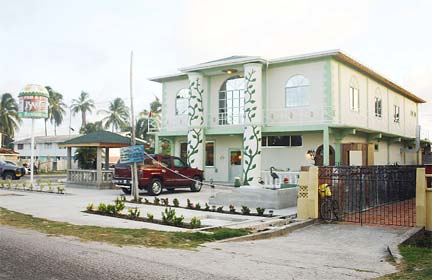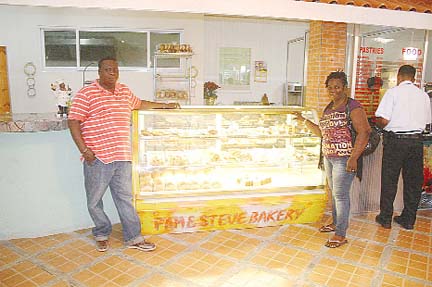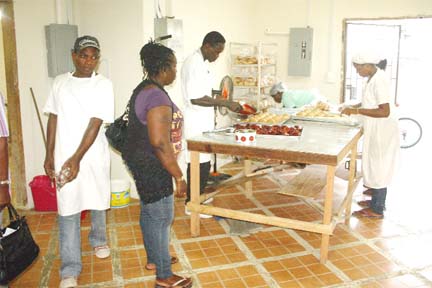An investment in old-fashioned taste and values
If you happen upon the imposing concrete structure sitting squarely on the corners of Stone Avenue and Fourth Streets in Campbellville, it appears not to belong in a neighbourhood better known for and far more modest, older generation of architecture comprising rows of small, ageing one-flat dwelling houses built more than half a century ago. The view from Fourth Street is dominated by two huge and attractive stone columns, the style borrowed from a Las Vegas structure. The forecourt houses a small, neat concrete benab and a sizeable area of open space where, almost a month after the doors of the premises were open for business, construction workers still work diligently to put the finishing touches to what will soon become one of the city’s largest open air eating houses.

Pam and Steve Bruce are a pair of modest, engaging United States-based Guyanese whose multi-million dollar investment in the venture that they have named Pam and Steve Bakery and Restaurant seems set to bring a considerable measure of positive transformation to an otherwise quiet residential community not otherwise known for any meaningful commercial pursuits.
Trading – in an impressive range of baked products including ‘home made’ breads and a selection of cakes and pastries, some fashioned after the offerings of decades ago and more contemporary cooked meals – has already started. The whole enterprise, however, including an outdoor eating area and what Steve says will be an “upscale” banqueting hall on the upper floor of the building, is still a work in progress. Already however, Pam and Steve Bakery and Restaurant has attracted a clientele that goes beyond its own neighbourhood.

The two are not new to business. Since 1998 they have been operating a similar enterprise in Brooklyn, offering to the Guyanese and wider West Indian community the kind of culinary nostalgia that has attracted an impressive level of local support. Pam has been residing in the United States for more than thirty years. Steve, who left Guyana much later met his wife in 1997, in a Brooklyn Laundromat. The story of their partnership, he says, embodies a mutual interest in enterprise. Pam had been baking and selling pastries as a means of making extra money in a financially demanding New York environment. Steve, prior to his own migration, had grown tired of being a wage-earner and, between 1985 and 1994 had thrown himself into various entrepreneurial pursuits ………….first, as a stallholder in Stabroek Market, then as a shop proprietor in the interior. “These,” he says, “were tough years,” and in 1988 he returned to paid employment with the then Guyana Airways Corporation.

In New York he found work with Chase Manhattan Bank, among other places but the ‘infection’ inflicted by the business bug that had bitten him in Guyana refused to heal. Meeting Pam, he says, was a turning point in both their lives.
Steve is open and blunt about his investment in Guyana. The decision to ‘take the plunge,’ to place considerable resources in an economic environment that has always not enjoyed glowing reviews in the diaspora is, he says, the outcome of a persistent preoccupation with making a mark in his own country and an abiding faith in the business acumen of team Pam and Steve.
In explaining his choice of the location of the enterprise in a working class neighbourhood on the outskirts of Georgetown he tells an engaging story of one of his staunchest Brooklyn patrons, an ageing Guyanese woman whose persistence and seeming faith in him finally persuaded him to accept her offer to sell him the land on which his dreams now stand.
The project commenced less than two years ago and has been brought close to completion with impressive speed. Steve and Pam are mindful of what they say is an obligation that businesses owe to the communities in which they operate. His staff includes residents of the community.
Both Pam and Steve are preoccupied with standards, with sustaining a quality of service that will endear what they are offering to the patrons that they serve. Steve talks about his recipes, his special formulae, tried and proven in Brooklyn and now very much on trial in Guyana. He is patient, holding to the belief that persistent high standards will eventually win the day.
Pam, a woman with a shy, engaging smile that belies her strong business convictions says her ‘piece’ quietly but authoritatively. When we asked Steve if he could estimate the time it would take to complete the upstairs banqueting hall he responded that the end of February might be a likely time frame. Pam intervened, volunteering a much later date and pointing out in the process that the furnishing and décor which she envisaged would take a much longer time to acquire and install. Steve did not seem inclined to contradict her, pointing out instead that their differences were an essential strength of what continues to be a highly successful team.
When you survey the considerable expanse of neat concrete floor that is the outside of the attractive interior of the building you cannot help but raise the question about the possibility of a huge entertainment area to rival the night clubs in downtown Georgetown. Pam and Steve respond with a collective frown. “No alcohol,” Steve responds. “That is not what we are about.” Some of his staunchest friends and supporters, he says, frown on the very idea and besides, he points out, “there are two churches in the immediate neighbourhood.” And if you want to utilize the facility of the soon-to-be-completed banqueting hall, Pam says, management will need to be persuaded of the nature of your function. When you seek clarification she responds quickly “no pay parties.”
